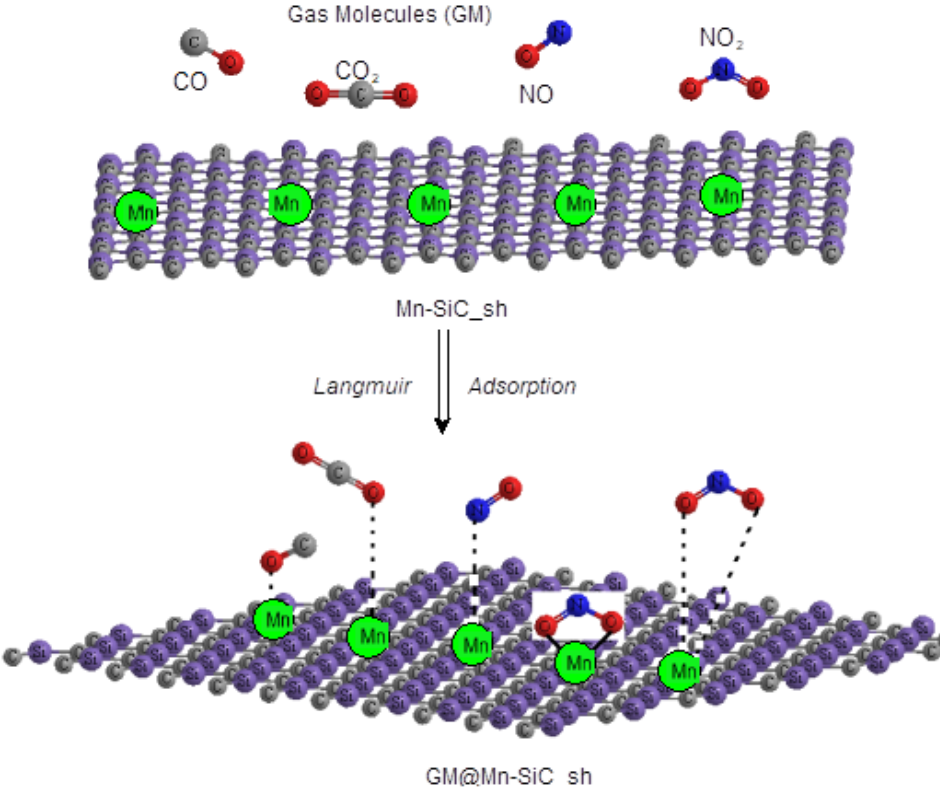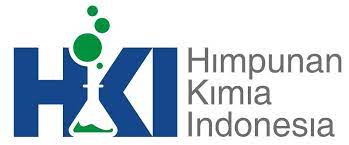
Gas Detecting Evaluation by Graphitic-based Silicon Carbide Nanosurface doped with Manganese: A Promising Device for Air Pollution Monitoring
Authors
Fatemeh MollaaminDOI:
10.29303/aca.v7i1.171Published:
2024-04-19Issue:
Vol. 7 No. 1 (2024)Keywords:
Mn–SiC_sh, CO, CO2, NO, NO2, gas detectorArticles
Downloads
How to Cite
Downloads
Metrics
Abstract
Silicon carbide (SiC) as a direct broad bandgap semiconducting material has the potential to bring a considerable developement into optoelectronic and electronic devices. This article aims to investigate
Physico-chemical properties of manganese (Mn)–doped graphene-like silicon carbide (SiC) monolayer sheet by the first-principles methods based on the density functional theory (DFT) for scavenging of CO, CO2, NO, NO2 gas molecules. The results recommend that the adsorption of these gas molecules on Mn-embedded SiC sheet monolayer is more energetically desired than that on the pristine ones. Gas molecules of CO, CO2, NO, NO2 have been adsorbed on the Mn site of doped SiC monolayer through the formation of covalent bonds. The assumption of chemical adsorptions has been approved by the projected density of states (PDOS) and charge density difference plots. Charge density difference calculations also indicate that the electronic densities were mainly accumulated on the adsorbate of CO, CO2, NO, NO2 gas molecules. The ability of SiC nanosheet for monitoring of CO, CO2, NO and NO2 is fluctuated by their selectivity and sensitivity through NMR, NQR, IR and HOMO/LUMO approaches which can represent the efficiency of Mn–doped SiC surface as the promising sensors toward air pollution detecting.
References
Novoselov, K.S., Geim, A.K., Morozov, S.V., Jiang, D., Zhang, Y., Dubonos, S.V., Grigorieva, I.V., Firsov, A.A.: Electric field effect in atomically thin carbon films. Science 306, 666–669 (2004)
Geim, K.: Graphene: status and prospects. Science 324, 1530–1534 (2009)
Castro Neto, A.H., Guinea, F., Peres, N.M.R., Novoselov, K.S., Geim, A.K.: The electronic properties of graphene. Rev. Mod. Phys. 81, 109–162 (2009)
Mak, K.F., Lee, C., Hone, J., Shan, J., Heinz, T.F.: Atomically thin mos2: a new direct-gap semiconductor. Phys. Rev. Lett. 105, 136805–136807 (2010)
Radisavljevic, B., Radenovic, A., Brivio, J., Giacometti, V., Kis, A.: Single-layer MoS2 transistors. Nat. Nanotechnol. 6, 147–150 (2011)
Rodin, S., Carvalho, A., Castro Neto, A.H.: Strain-induced gap modification in black phosphorus. Phys. Rev. Lett. 112, 176801–176803 (2014)
Low, T., Rodin, A.S., Carvalho, A., Jiang, Y., Wang, H., Xia, F., Castro Neto, A.H.: Tunable optical properties of multilayer black phosphorus thin films. Phys. Rev. B 90, 075434–074538 (2014)
Fei, R., Faghaninia, A., Soklaski, R., Yan, J.A., Lo, C., Yang, L.:Enhanced thermoelectric efficiency via orthogonal electrical and thermal conductances in phosphorene. Nano Lett. 14, 6393–6399
(2014).
Ramasubramaniam, A., Muniz, A.R.: Ab initio studies of thermodynamic and electronic properties of phosphorene nanoribbons.Phys. Rev. B 90, 085424–085429 (2014)
Mollaamin, F.; Monajjemi, M. Doping of Graphene Nanostructure with Iron, Nickel and Zinc as Selective Detector for the Toxic Gas Removal: A Density Functional Theory Study. C 2023, 9, 20. https://doi.org/10.3390/c9010020.
Ziqi Yan, Yu Bai and Lingjie Sun, Adsorption of thiophene and SOx molecules on Cr-doped and Ti-doped graphene nanosheets: a DFT study. Materials Research Express, 6 (12), 2019. Doi: 10.1088/2053-1591/ab599d.
Mollaamin, F.; Monajjemi, M. Graphene Embedded with Transition Metals for Capturing Carbon Dioxide: Gas Detection Study Using QM Methods. Clean Technol. 2023, 5(1), 403–417. https://doi.org/10.3390/cleantechnol5010020.
Mollaamin, F., Monajjemi, M. Transition metal (X = Mn, Fe, Co, Ni, Cu, Zn)-doped graphene as gas sensor for CO2 and NO2 detection: a molecular modeling framework by DFT perspective. J Mol Model 29, 119 (2023). https://doi.org/10.1007/s00894-023-05526-3.
Narushima, T., Goto, T., Hirai, T., Iguchi, Y.: High-temperature oxidation of silicon carbide and silicon nitride. Mater. Trans. JIM 38, 821–835 (1997)
Zhang, X.H., Han, J.C., Zhou, J.G., Xin, C., Zhang, Z.H., Song, B.: Ferromagnetism in homogeneous (Al, Co)-codoped 4h-silicon carbides. J. Magn. Magn. Mater. 363, 34–42 (2014)
Casady, J.B., Johnson, R.W.: Status of silicon carbide (SiC) as a wide-band gap semiconductor for high-temperature applications: a review. Solid-St. Electron 39, 1409–1422 (1996).
Lin, S.S.: Light-emitting two-dimensional ultrathin silicon carbide. J. Phys. Chem. C. 116, 3951–3955 (2012) .
Hsueh, H.C., Guo, G.Y., Louie, S.G.: Excitonic effects in the optical properties of a SiC sheet and nanotubes. Phys. Rev. B 84, 085404–085413 (2011)
Eliseeva, N.S., Kuzubov, A.A., Ovchinnikov, S.G., Serzhantova, M.V., Tomilin, F.N., Fedorov, A.S.: Theoretical study of the magnetic properties of ordered vacancies in 2D hexagonal structures: graphene, 2D-SiC, and H-BN. JETP Lett. 95, 555–559 (2012)
Lee Hoonkyung, Ihm Jisoon, Marvin Cohen L, Louie Steven G. Calcium-decorated carbon nanotubes for high-capacity hydrogen storage: first-principles calculations. Phys Rev B 2009; 80:115412.
Bekaroglu, E., Topsakal, M., Cahagirov, S., Ciraci, S.: Firstprinciples study of defects and adatoms in silicon carbide honeycomb structures. Phys. Rev. B 81, 075433–075441 (2010)
Alaal, N., Loganathan, V., Medhekar, N., Shukla, A.: First principles many-body calculations of electronic structure and optical properties of SiC nanoribbons. J. Phys. D: Appl. Phys. 49, 105306–105314 (2016)
Javan, M.B.: Electronic and magnetic properties of monolayer SiC sheet doped with 3d-transition metals. J. Magn. Magn. Mater. 401, 656–661 (2016)
Wu, Y., Zhou, L.P., Du, X.Z., Yang, Y.P.: Near-field radiative heat transfer between two SiC plates with/without coated metal films. J. Nanosci. Nanotechno. 15, 3017–3024 (2015)
Bekaroglu, E., Topsakal, M., Cahagirov, S., Ciraci, S.: Firstprinciples study of defects and adatoms in silicon carbide honeycomb structures. Phys. Rev. B 81, 075433–075441 (2010)
Alaal, N., Loganathan, V., Medhekar, N., Shukla, A.: First principles many-body calculations of electronic structure and optical properties of SiC nanoribbons. J. Phys. D: Appl. Phys. 49, 105306–105314 (2016)
Javan, M.B.: Electronic and magnetic properties of monolayer SiC sheet doped with 3d-transition metals. J. Magn. Magn. Mater. 401, 656–661 (2016)
Wu, Y., Zhou, L.P., Du, X.Z., Yang, Y.P.: Near-field radiative heat transfer between two SiC plates with/without coated metal films. J. Nanosci. Nanotechno. 15, 3017–3024 (2015)
Kresse, G., Furthm¨ uller, J.: Efficient iterative schemes for ab initio total-energy calculations using a plane-wave basis set. Phys. Rev. B 54, 11169–11186 (1996)
Perdew, J.P., Burke, K., Ernzerhof, M.: Generalized gradient approximation made simple. Phys. Rev. Lett. 77, 3865–3868 (1996)
Kresse, G., Joubert, D.: From ultrasoft pseudopotentials to the projector augmented-wave method. Phys. Rev. B 59, 1758–1775 (1999)
Miyamoto Y, Yu BD. Computational designing of graphitic silicon carbide and its tubular forms. Appl Phys Lett 2002;80: 586e8.
Fatemeh Mollaamin, Sara Shahriari, Majid Monajjemi, Zahra Khalaj, Nanocluster of Aluminum Lattice via Organic Inhibitors Coating: A Study of Freundlich Adsorption. Journal of Cluster Science 2022, 1-16. https://doi.org/10.1007/s10876-022-02335-1.
Monajjemi, M.; Mollaamin, F.; Gholami, M.R.; Yoosbashizadeh, H.; Sadrnezhad, S.K.; Passdar, H. Quantum Chemical Parameters of Some Organic Corrosion Inhibitors, Pyridine, 2-Picoline 4-Picoline and 2,4-Lutidine, Adsorption at Aluminum Surface in Hydrochloric and Nitric Acids and Comparison Between Two Acidic Media. Main Group Met. Chem. 2003, 26, 349-362, https://doi.org/10.1515/MGMC.2003.26.6.349.
Dennington R, Keith TA, Millam JM. GaussView. Version 6. Shawnee Mission (KS): Semichem Inc., 2016.
Frisch, M. J.; Trucks, G. W.; Schlegel, H. B.; Scuseria, G. E.; Robb, M. A.; Cheeseman, J. R.; Scalmani, G.; Barone, V.; Petersson, G. A.; Nakatsuji, H. et al. Gaussian 16, Revision C.01, Gaussian, Inc., Wallingford CT, 2016.
Perdew, J.P.; Burke, K.; Ernzerhof, M. Generalized Gradient Approximation Made Simple. Phys. Rev. Lett. 1996, 77, 3865.
Svensson,M.; Humbel,S.; Froese,R.D.J.; Matsubara,T.; Sieber,S.; and Morokuma,K. ONIOM: A Multilayered Integrated MO + MM Method for Geometry Optimizations and Single Point Energy Predictions. A Test for Diels−Alder Reactions and Pt(P(t-Bu)3)2 + H2 Oxidative Addition. J. Phys. Chem. 1996, 100(50) , 19357–19363. https://doi.org/10.1021/jp962071j.
Lehtola, S. A review on non-relativistic fully numerical electronic structure calculations on atoms and diatomic molecules". Int. J. Quantum Chem. 2019, 119 (19): e25968. doi:10.1002/qua.25968.
G Henkelman, A Arnaldsson, and H Jónsson, “A fast and robust algorithm for Bader decomposition of charge density,” Computational Materials Science 36(3), 354-360 (2006).
Y G Zhou, X T Zu, F Gao et al., “Electronic and magnetic properties of graphene absorbed with S atom: A first-principles study,” Journal of Applied Physics 105(10), 104311 (2009).
Y Mao, J Yuan, and J Zhong, “Density functional calculation of transition metal adatom adsorption on graphene,” Journal of Physics: Condensed Matter 20(11), 115209 (2008).
43.Smith, J. A. S. Nuclear Quadrupole Resonance Spectroscopy. Journal of Chemical Education. 48: 39–41, 1971.
Lucken, E.A.C. Nuclear Quadrupole Coupling Constants; Academic Press Inc.: London, UK; New York, NY, USA, 1969.
Trontelj, Z.; Pirnat, J.; Jazbinšek, V.; Lužnik, J.; Srčič, S.; Lavrič, Z.; Beguš, S.; Apih, T.; Žagar, V.; Seliger, J. Nuclear Quadrupole Resonance (NQR)—A Useful Spectroscopic Tool in Pharmacy for the Study of Polymorphism. Crystals 2020, 10, 450. https://doi.org/10.3390/cryst10060450.
46.Young, Hugh A.; Freedman, Roger D. (2012). Sears and Zemansky's University Physics with Modern Physics (13th ed.). Boston: Addison-Wesley. p. 754.
47. El Nokab, M.E.H.; Alassmy, Y.A.; Abduljawad, M.M.; Al-shamrani, K.M.; Alnafisah, M.S.; Asgar Pour, Z.; Tucker, C.L.; Sebakhy, K.O. Solid-State NMR Spectroscopy: Towards Structural Insights into Starch-Based Materials in the Food Industry. Polymers 2022, 14, 4686. https://doi.org/10.3390/polym14214686.
48. Kazak, A.; Marchenkova, M.; Smirnova, A.; Dubinina, T.; Seregin, A.; Rogachev, A.; Usoltseva, N. Thin-film materials based on phthalocyanine derivatives: Structure and physico-chemical properties. ITM Web Conf. 2019, 30, 08006. https://doi.org/10.1051/itmconf/20193008006.
49. González-Díaz, J.; García-Martín, A.; Armelles, G.; García-Martín, J.; Clavero, C.; Cebollada, A.; Lukaszew, R.; Skuza, J.; Kumah, D.; Clarke, R. Surface-magnetoplasmon nonreciprocity effects in noble-metal/ferromagnetic heterostructures. Phys. Rev. B 2007, 76, 153402. https://doi.org/10.1103/PhysRevB.76.153402.
50. Rizal, C. Magneto-Optic Surface Plasmon Resonance Ti/Au/Co/Au/Pc Configuration and Sensitivity. Magnetochemistry 2018, 4, 35. https://doi.org/10.3390/magnetochemistry4030035.
51. Manera, M.G.; Giancane, G.; Bettini, S.; Valli, L.; Borovkov, V.; Colombelli, A.; Lospinoso, D.; Rella, R. MagnetoPlasmonic Waves/HOMO-LUMO Free π-Electron Transitions Coupling in Organic Macrocycles and Their Effect in Sensing Applications. Chemosensors 2021, 9, 272. https://doi.org/10.3390/chemosensors9100272.
License
Copyright (c) 2024 Fatemeh Mollaamin

This work is licensed under a Creative Commons Attribution-NonCommercial-ShareAlike 4.0 International License.
Authors who publish with ACA: Acta Chimica Asiana agree to the following terms:
- Authors retain copyright and grant the journal right of first publication with the work simultaneously licensed under a Creative Commons Attribution-NonCommercial-ShareAlike 4.0 International License. This license allows authors to use all articles, data sets, graphics, and appendices in data mining applications, search engines, web sites, blogs, and other platforms by providing an appropriate reference. The journal allows the author(s) to hold the copyright without restrictions and will retain publishing rights without restrictions.
- Authors are able to enter into separate, additional contractual arrangements for the non-exclusive distribution of the journal's published version of the work (e.g., post it to an institutional repository or publish it in a book), with an acknowledgement of its initial publication in ACA: Acta Chimica Asiana.
- Authors are permitted and encouraged to post their work online (e.g., in institutional repositories or on their website) prior to and during the submission process, as it can lead to productive exchanges, as well as earlier and greater citation of published work (See The Effect of Open Access).





 Indonesian Chemical Society, Chapter Nusa Tenggara. Jalan Majapahit 62 Mataram, University of Mataram, 83125, Indonesia
Indonesian Chemical Society, Chapter Nusa Tenggara. Jalan Majapahit 62 Mataram, University of Mataram, 83125, Indonesia





